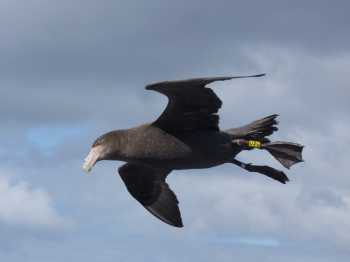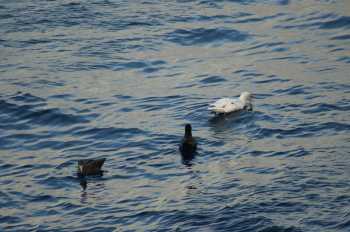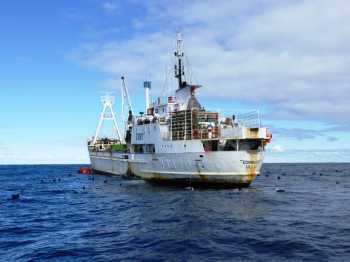Southern Giant Petrels Macronectes giganteus exhibit marked sexual dimorphism. So much so that a study on Gough Island in the South Atlantic (the species' most northerly breeding population) found no overlap in culmen between males and females (click here).
Several studies have shown dietary differences between the sexes, with the larger males feeding on prey obtained terrestrially, and smaller females feeding on more obviously marine prey. Further, observations of scavenging groups on island shorelines show that practically all the birds present are males. This is thought to be because the males would be able to out-compete the noticeably smaller females as they squabble among themselves over a seal carcass or the like.
Less evidence exists on the gender makeup of giant petrels seen at sea, since making size comparisons in a moving environment is tricky to say the least. However, if birds are colour-banded at study colonies when they are sexed by measurements the opportunity does occasionally arise to gather useful information from vessels at sea.
On 11 October last year Brad Robson of the Royal Society for the Protection of Birds observed up to 300 Southern Giant Petrels in the water off the shoreline of Nightingale Island in the Tristan da Cunha Group. Out of this large number he managed to read the colour bands of 12 birds, all of which had been banded in the previous and current breeding season in the Low Hump colony on Gough Island, c. 400 km away. Based on measurements made when banded, all 12 birds were females. Previously, eight colour-banded birds from Gough have been spotted off the main island of Tristan, of which six were females and two males (click here).
The overall ratio of 18 females to two males does support the view that females forage at sea more than do males in this species, noting that equal numbers of males and females (as breeding pairs) have been banded on Gough.

Identified on the wing: Yellow D60 from Gough Island flys by
A white-phase Southern Giant Petrel off Nightingale Island: not a Gough bird
Southern Giant Petrels cluster around the Edinburgh, a crayfish fishing vessel, off Nightingale
Photographs by Brad Robson
References:
Cooper, J. & Parker, G.C. 2011. Observations of sexual dimorphism among the Southern Giant Petrels Macronectes giganteus of Gough Island. Sea Swallow 60: 84-90.
González-Solís, J., Croxall, J.P. & Wood, A.G. 2000. Foraging partitioning between giant petrels Macronectes spp. and its relationship with breeding population changes at Bird Island, South Georgia. Marine Ecology Progress Series 204: 279-288.
With thanks to Brad Robson for information and photographs
John Cooper, ACAP Information Officer, 7 January 2012

 English
English  Français
Français  Español
Español